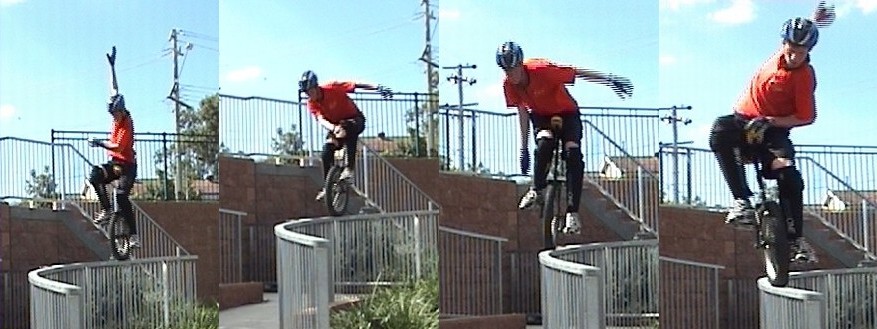This would be easier with pictures, but I haven’t figured out how to do that easily in a regular post so here goes:
Imagine two vertically elongated masses with one stacked on top of the other and joined together with a powered hinge. The lower mass represents your legs, hips and the unicycle. The upper mass represents your torso, head and arms. The hinge and power source are your waist and abdominal/back muscles.
Since you can roll on a thin rail you can control your fore and aft balance with normal pedaling. This frees your abdominal/back muscles from the need to balance a still stand in that direction so there is more “power” for still-standing in the lateral direction.
So, imagine that you are looking down the rail. Mentally “float” the two mass system an inch over the rail. (“Matrix” physics rules are in effect - gravity is suspended.) Imagine the system is perfectly still and aligned perfectly straight and vertical. What happens if the hinge “motors” are actuated to bend the top to the right? Conservation of momentum (Newton’s first law) says that the center of mass stays put, since there are no externally applied forces (the “tire” isn’t touching the rail). Further, there is no reason for the system to rotate as a whole since there are no externally applied torques either. So the top and bottom of the system move to the right, and the waist moves to the left. The center of mass of the upper mass stays on the vertical line but moves down, and the center of mass of the lower mass stays on the line and moves up. The overall center of mass stays put.
Now, mentally straighten the masses out again and turn gravity on. The mass system drops onto the rail and balances. If everthing is PERFECTLY alligned it will just stay there, however this perfection is only possible in cartoons and computer simulations. In the real world it will never happen. Eventually it will begin to rotate around the contact point on the rail and fall. Why?
With gravity turned on the mass system pushes down on the rail, and the rail in turn pushes up on the mass system. When the system is perfectly vertical these two pushes are exactly in alignment and cancel out. When the mass system tips, even a tiny amount, the two pushes become slightly offset. This creates something called a “couple” in physics that creates a pure twisting force or “torque”. Since these forces are externally applied Newton’s second law comes into effect - the masses accelerate. As the masses tip they also start to accelerate sideways because the rail “up” push is no longer exactly vertical.
Now imagine that the masses are still aligned straight with each other but have tipped a tiny bit to the right. What happens if the “motor” in the waist is actuated to rotate the top mass strongly to the right?
In the zero gravity thought experiment the top part rotated to the right and the lower part rotated to the left. But in the gravity-on case the “tire” is in contact with the “rail” so the bottop part isn’t free to rotate anymore. In the free-air this floating tire tread would have moved to the right too, but since it is in contact it can’t, so the whole system is pulled to the left.
Now, mentally stop time: What happens if you bend the system at the waist and then straighten it in the same instant? The answer is nothing. It will go back to exactly how it was. So managing time must be part of the solution for still standing. Ok, start time again:
When the tire patch causes the system to move to the left it causes the center of mass to move to the LEFT of the rail. Now the tipping couple is reversed and the masses start to fall to the left. After a suitable period of time imagine the motor is actuated again to straighten the system. This causes the center of mass to move to the right, but since the masses spent some time falling to the left it doesn’t go back to where it started from. If the timing and movements are done perfectly the center of mass will wind up right over the rail and the system is back in balance.
So what about the arm windmilling? Well, it’s the same thing but with three masses (and a new powered hinge at the shoulder.) When you start your arm rotation you cause the tire to pull your center of gravity one way, and when you stop the rotation it pulls you the other way. Get the timing right and you stay over the rail.
This form of balance isn’t limited to unicycleing. Watch any good soccer player in slow motion and you will see the arm-swings and waist bends helping him (or her) maneuver. Or just go down to the bar and watch the really drunk folks - since their balance and timing systems are impared you can see in an exagerated sense the waist bends and arm swings that we all do to just stand and walk on our feet.
Hope it helps. For the video I’d have an illustrator make some animations. Long leather coats optional for the “Matrix” physics section.
Tim

